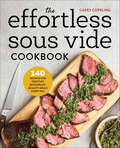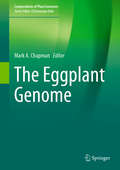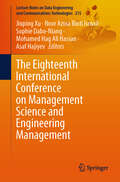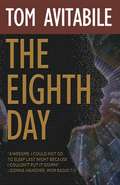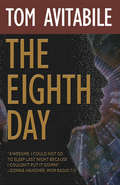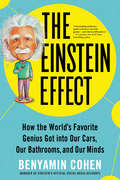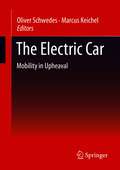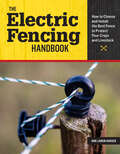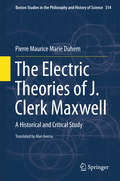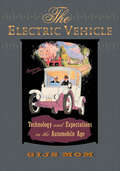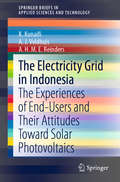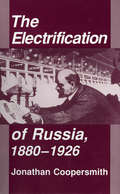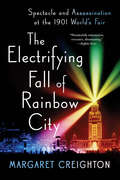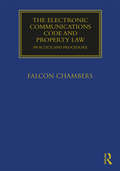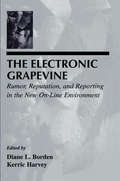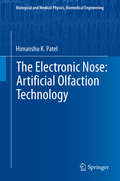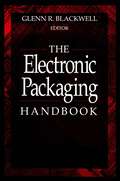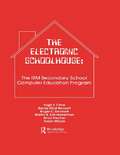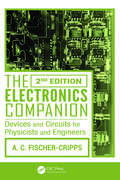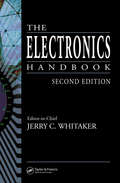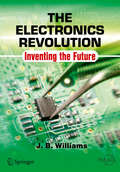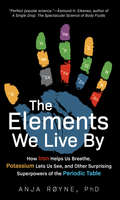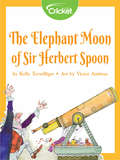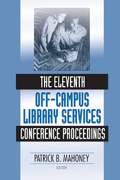- Table View
- List View
The Effortless Sous Vide Cookbook: 140 Recipes for Crafting Restaurant-Quality Meals Every Day
by Carey CopelingThe Effortless Sous Vide Cookbook serves easy, everyday recipes for restaurant-quality mealsIt's easy to make perfectly cooked food with your sous vide, but finding the right recipes to do it night after night can be tricky. The Effortless Sous Vide Cookbook serves well-rounded, restaurant-quality meals for easy, everyday cooking. Featuring 140 no-fuss recipes, plus an overview of basic practices and new sous vide cooking techniques, The Effortless Sous Vide Cookbook transforms every kitchen into a Michelin-star restaurant.The Effortless Sous Vide Cookbook includes:Over 140 Weeknight Recipes for making vegetables, fish and seafood, red meat, poultry, dessert, and even drinks!Sous Vide 101 covering the basic sous vide practices along with new techniquesQuick Reference Guides featuring helpful charts to help you gage timing, temperature, and power to your modelSous vide cookbook recipes include: Vegetable Halloumi Kebabs, Seared Wasabi Ahi Tuna, Rosemary Veal Chop, Peanut Chicken Satay, Duck Confit, Salted Caramel Cheesecake, Espresso Martini, and much more!Make perfectly cooked meals a staple at your table with The Effortless Sous Vide Cookbook.
The Egg and I
by Betty MacdonaldThis is the first book, which Betty MacDonald wrote. It chronicles her real-life adventures with her first husband--a man who built a good barn long before fixing the rundown house. Other books by Betty MacDonald are available from Bookshare.
The Eggplant Genome (Compendium of Plant Genomes)
by Mark A. ChapmanThe book discusses the importance of eggplant (Solanum melongena L.) as a crop, highlighting the potential for eggplant to serve as a model for understanding several evolutionary and taxonomic questions. It also explores the genomic make-up, in particular in comparison to other Solanaceous crops, and examines the parallels between eggplant and tomato domestication as well as between the most common eggplant species and two related eggplants native to Africa (Ethiopian eggplant [Solanum aethiopicum L.] and African eggplant [Solanum macrocarpon L.]).The eggplant genome was first sequenced in 2014, and an improved version was due to be released in 2017. Further investigations have revealed the relationships between wild species, domesticated eggplant, and feral weedy eggplant (derived from the domesticate), as well as targets of selection during domestication. Parallels between eggplant and tomato domestication loci are well known and the molecular basis is currently being investigated.Eggplant is a source of nutrition for millions of people worldwide, especially in Southeast Asia where it is a staple food source. Domesticated in the old world, in contrast to its congeners tomato and potato, the eggplant is morphologically and nutritionally diverse. The spread of wild eggplants from Africa is particularly interesting from a cultural point of view. This book brings together diverse fields of research, from bioinformatics to taxonomy to nutrition to allow readers to fully understand eggplant’s importance and potential.
The Eighteenth International Conference on Management Science and Engineering Management (Lecture Notes on Data Engineering and Communications Technologies #215)
by Jiuping Xu Asaf Hajiyev Sophie Dabo-Niang Mohamed Hag Ali Hassan Noor Azina Binti IsmailThe proceedings of the Eighteenth ICMSEM cover a wide range of areas including hot management issues in Engineering Science. It provides newest and frontier ideas and research achievements in the area of Management Science and Engineering Management to researchers and practitioners. The work contains both theoretical and practical studies of Management Science in the Computing Methodology, showing the advanced management concepts, computing technologies for decision making problems with large, uncertain and unstructured data. Research in this proceeding will show the new changes and challenges in the decision-making procedure as we have entered the big data era. Theoretical studies of this proceedings will present the new technologies of analysis, capture, search, sharing, storage, transfer, visualization, and privacy violations, as well as advances in integration of optimization, statistics and data mining. This proceeding also contains practical studies in the real decision-making scenarios when facing large, uncertain or unstructured data. The readers who are interested in related fields of can benefit from the proceedings for the new ideas and research direction.
The Eighth Day
by Tom AvitabileA chemical engineer sets in motion a horrendous explosion killing hundreds of commuters and himself.Hollywood's hottest sex symbol assassinates a sitting senator.A grandmother stages a sophisticated attack on a train causing massive damage.An airplane full of Silicon Valley's brightest is blown up while refueling.A series of deadly, unrelated events or the unlikely start of an insidious new terror network?As Science Advisor to the President, William "Wild Bill" Hiccock is tasked with assembling a team to identify and stop the threat, whether homegrown or foreign. His team - a retired Navy admiral, a wise-guy computer hacker sprung from federal prison, and his ex-wife, a leading behavioral psychologist - must identify and destroy their elusive adversary who always seems to be a step ahead.
The Eighth Day: Quarterback Operations Group Book 1 (Quarterback Operations Group #1)
by Tom AvitabileIn this action-packed political thriller, a motley crew is assembled to aid the US government in deciphering what&’s causing a series of bizarre attacks before it&’s too late. A chemical engineer sets in motion a horrendous explosion killing hundreds of commuters and himself. Hollywood&’s hottest sex symbol assassinates a sitting senator. A grandmother stages a sophisticated attack on a train causing massive damage. An airplane full of Silicon Valley&’s brightest is blown up while refueling. A series of deadly, unrelated events, or the unlikely start of an insidious new terror network? As science advisor to the president, William &“Wild Bill&” Hiccock is tasked with assembling a team to identify and stop the threat, whether homegrown or foreign. His team—a retired Navy admiral, a wise-guy computer hacker sprung from federal prison, and his ex-wife, a leading behavioral psychologist—must identify and destroy their elusive adversary who always seems to be one step ahead. &“Awesome. I could not go to sleep last night because I couldn&’t put it down.&” —Donna Hanover, WOR Radio 710 &“Frighteningly realistic. Most of Washington really works this way. Homeland Security had better read this one and take corrective action.&” —Michael Skol, US Ambassador &“The author weaves a tale that will occasionally take your breath away and then cause you to sigh with relief . . . He is a master wordsmith who knows the value of just the right phrase at just the right moment. His timing will keep you on the edge of your chair.&” —Bill Twomey, CNG Newspaper Group &“A thriller with some insights into human behavior.&” —Mel Robbins, CNBC
The Einstein Effect: How the World's Favorite Genius Got into Our Cars, Our Bathrooms, and Our Minds
by Benyamin Cohen"A fascinating and funny guide to history's favorite genius—and why he still matters." —A.J. Jacobs, New York Times bestselling authorA fascinating look into how Einstein's genius and science continues to show up in so many facets of our everyday lives and his enduring legacy as an unlikely pop culture icon.Albert Einstein was the first modern-day celebrity and, decades after his death, still has the world's most recognizable face. His influence is seen in much of the technology we use every day: GPS, remote controls, weather forecasts, even toothpaste. But it's not just Einstein's scientific discoveries that continue to shape our world. His legacy underpins the search for aliens, the rescue of refugees, the invention of time machines, and the debunking of fake news. He appears in new books, TV shows, and movies all the time—and fans are paying millions for Einstein relics at auction.Award-winning author and journalist Benyamin Cohen has a bizarre side hustle as the manager of Einstein's official social media accounts, which have 20 million followers—more than most living celebrities. In The Einstein Effect, Cohen embarks on a global quest to unearth Einstein's ongoing relevance today. Along the way, he meets scientists and celebrities, speaks to dozens with the last name Einstein (including two rabbis), and even tracks down the brain of Einstein, stolen from his body during the autopsy. Cohen shows us the myriad ways the Nobel Prize winner's influence is still with us, giving an in-depth—and often hilarious—look at the world's favorite genius like you've never seen him before.Praise for The Einstein Effect:"Benyamin is a regular Joe with great humility, a tremendous sense of humor, a philosopher with an acute awareness of human connection, a gift to us all." —Mandy Patinkin, actor, singer, activist"I hope this book encourages others to be inspired by Einstein as well." —Christopher Lloyd, award-winning actor"A book for geniuses and the rest of us alike." —Derek Baxter, author of In Pursuit of Jefferson"A thoroughly entertaining new book." —Jeff Einstein, great-great nephew of Albert Einstein"Full of humor and surprises." —Paul Halpern, physics professor and author of Einstein's Dice and Schrödinger's Cat
The Electric Car: Mobility in Upheaval
by Oliver Schwedes Marcus KeichelThe volume is dedicated to the electric car. It examines the extent to which the electric car can contribute to sustainable transport development as part of a new mobility culture. The technical, cultural, political, social and aesthetic dimensions are considered. It will be shown how the general social framework has to change in order to make the electric car a success.This book is a translation of the original German edition "Das Elektroauto“ by “Marcus Keichel”, published by Springer Fachmedien Wiesbaden in 2013. The translation was done with the help of artificial intelligence (machine translation by the service DeepL.com). A subsequent human revision was done primarily in terms of content, so that the book will read stylistically differently from a conventional translation. Springer Nature works continuously to further the development of tools for the production of books and on the related technologies to support the authors.
The Electric Fencing Handbook: How to Choose and Install the Best Fence to Protect Your Crops and Livestock
by Ann Larkin HansenUse electric fencing to protect your livestock, poultry, beehives, and garden. Portable electric fencing is key to successful rotational grazing, while permanent electric fencing effectively protects gardens and orchards and secures large pastures. Through clear instructions accessible to everyone, you’ll learn when to use these methods or a combination of the two, plus how to plan for, build, and maintain your electric fencing. This crucial tool is cost effective and versatile, but veteran farmer and author Ann Larkin Hansen also explains what not to do with an electric fence.
The Electric Theories of J. Clerk Maxwell
by Pierre Maurice Marie DuhemIn this volume Pierre Duhem first gives an overview of 19th century electricity and magnetism. Next, he applies his keen historical, philosophical, and physical intuition to critiquing Maxwell's theories, especially his electromagnetic theory of light and the ad hoc introduction of displacement current, which he considers too much a product of the "esprit de géométrie" than the "esprit de finesse," as Pascal calls it. In this book, Duhem is guided by the principle that a theory that offers contradictions, even if the theory is posed by a genius, needs to be analysed and discussed until a clear distinction can be made between the propositions likely to be logically demonstrated and statements that offend logic and which must be transformed or rejected. Furthermore, Duhem felt, in criticizing such a theory one must guard against narrowness of mind and petty corrections which would make one forget the merit of the inventor; and, more importantly, one must guard against the blind superstition which, for admiration of the author, would hide the serious defects of the work. He is not so great a genius that he surpasses the laws of reason. Pierre Duhem (1861-1916), chairman of theoretical physics at Bordeaux in 1984-1916, is well-known for his works in the history and philosophy of science.
The Electric Vehicle: Technology and Expectations in the Automobile Age
by Gijs MomWinner of the Engineer-Historian Award from the International History and Heritage Committee of the American Society of Mechanical Engineers, and the Nicholas-Joseph Cugnot Award given by the Society of Automotive HistoriansRecent attention to hybrid cars that run on both gasoline and electric batteries has made the electric car an apparent alternative to the internal combustion engine and its attendant environmental costs and geopolitical implications. Few people realize that the electric car—neither a recent invention nor a historical curiosity—has a story as old as that of the gasoline-powered automobile, and that at one time many in the nascent automobile industry believed battery-powered engines would become the dominant technology. In both Europe and America, electric cars and trucks succeeded in meeting the needs of a wide range of consumers. Before World War II, as many as 30,000 electric cars and more than 10,000 electric trucks plied American roads; European cities were busy with, electrically propelled fire engines, taxis, delivery vans, buses, heavy trucks and private cars. Even so, throughout the century-long history of electric propulsion, the widespread conviction it was an inferior technology remained stubbornly in place, an assumption mirrored in popular and scholarly memory. In The Electric Vehicle, Gijs Mom challenges this view, arguing that at the beginning of the automobile age neither the internal combustion engine nor the battery-powered vehicle enjoyed a clear advantage. He explores the technology and marketing/consumer-ratio faction relationship over four "generations" of electric-vehicle design, with separate chapters on privately owned passenger cars and commercial vehicles. Mom makes comparisons among European countries and between Europe and America.He finds that the electric vehicle offered many advantages, among them greater reliability and control, less noise and pollution. He also argues that a nexus of factors—cultural (underpowered and less rugged, electric cars seemed "feminine" at a time when most car buyers were men), structural (the shortcomings of battery technology at the time), and systemic (the infrastructural problems of changing large numbers of batteries)—ultimately gave an edge to the internal combustion engine. One hopes, as a new generation of electric vehicles becomes a reality, The Electric Vehicle offers a long-overdue reassessment of the place of this technology in the history of street transportation.
The Electricity Grid in Indonesia: The Experiences of End-Users and Their Attitudes Toward Solar Photovoltaics (SpringerBriefs in Applied Sciences and Technology)
by K. Kunaifi A.J. Veldhuis A.H.M.E ReindersIn 2017, nearly 60 million households in Indonesia were connected to the national power grid. Accordingly, we believe that their ‘voice’ is important to maintain democratic and participatory values in planning electricity services. However, what is actually the voice of electricity users in Indonesia? Also, what can we learn from it when looking at the fitness of the electricity supply in Indonesia in the context of costs, reliability, and environmental aspects? This book presents the real experience of households, some of the grid users in Indonesia. Through a series of surveys in 2017, households in three cities in Western, Central, and Eastern Indonesia shared their experiences and preferences regarding their electricity supply. They offered their opinions about the stability and reliability of electricity supply, how they coped with blackouts, and what impacts power interruptions had on their daily lives. Because of the frequent power outages, the users started to think about the importance of having a back-up power generator at home. Given that Indonesia has high solar irradiance the whole year through, we also observed the users’ attitudes toward solar photovoltaic (PV) systems. The book starts with a brief introduction about Indonesia followed by the status and challenges of power supply in the country. Then, in the middle section, the users’ voices are presented. Finally, the potential of PV systems, as a promising solution to increasing electricity access and improving the reliability of electricity supply in this tropical country, is presented. We believe that this book provides useful information for the transition to the use of solar energy in energy systems in Indonesia, which is meant for academia, electric utility companies, PV system actors, policymakers, and of course, households in Indonesia.
The Electrification of Russia, 1880–1926
by Jonathan CoopersmithThe Electrification of Russia, 1880–1926 is the first full account of the widespread adoption of electricity in Russia, from the beginning in the 1880s to its early years as a state technology under Soviet rule. Jonathan Coopersmith has mined the archives for both the tsarist and the Soviet periods to examine a crucial element in the modernization of Russia. Coopersmith shows how the Communist Party forged an alliance with engineers to harness the socially transformative power of this science-based enterprise. A centralized plan of electrification triumphed, to the benefit of the Communist Party and the detriment of local governments and the electrical engineers. Coopersmith’s narrative of how this came to be elucidates the deep-seated and chronic conflict between the utopianism of Soviet ideology and the reality of Soviet politics and economics.
The Electrifying Fall of Rainbow City: Spectacle and Assassination at the 1901 World's Fair
by Margaret CreightonThe Pan American Exposition in Buffalo, New York, meant to herald the twentieth century, went tragically, spectacularly awry. In 1901, Buffalo was the eighth-largest city in the United States, and its leaders had big dreams. They would host a world’s fair, showcasing the Americas, and bring millions of people to western New York. With nearby Niagara Falls as a drawing card and with stunning colors and electric lights, they hoped the fair would be more popular and more brilliant, literally, than Chicago’s White City of 1893. The Exposition opened with fanfare; its wonders, both strange and magnificent, dazzled the public. Then tragedy struck. In the early autumn of 1901, an assassin stalked the fairgrounds, waiting for President William McKinley. That was shocking enough, but there were more surprises in store. A female daredevil captivated crowds by trying to ride a barrel over Niagara Falls. Apache leader Geronimo startled visitors with a controversial performance. And a showman called the Animal King, the self-proclaimed star of the Midway, announced that one of his acts, the smallest woman in the world and the fair’s “mascot,” had been kidnapped. Then he staged the attempted electrocution of an elephant. In this extraordinary account, Margaret S. Creighton lifts the curtain on the assassination of McKinley as well as on the fair’s lesser-known battles, involving both notorious and forgotten figures. In a story that is by turns suspenseful, heartrending, and triumphant, she reveals the myriad power struggles that not only marked the Exposition but shaped the new century.
The Electronic Communications Code and Property Law: Practice and Procedure
by Falcon ChambersLife now without access to electronic telecommunications would be regarded as highly unsatisfactory by most of the UK population. Such ready access would not have been achieved without methodical and ultimately enforceable means of access to the land on which to install the infrastructure necessary to support the development of an electronic communications network. Successive governments have made such access a priority, regarding it as a principle that no person should unreasonably be denied access to an electronic communications network or electronic communications services. The enactment of the Telecommunications Act 1984 and its revision by the Communications Act in 2003 have played their role in the provision of an extensive electronic infrastructure in the UK, while their reshaping by means of the Digital Economy Act 2017 will continue that process. Throughout that process, a little publicised series of struggles has taken place between telecommunications operators and landowners, as they seek to interpret the Electronic Communications Code by which their rights and obligations have been regulated. This book describes the problems that accompanied the Old Code (which will continue to regulate existing installations and agreements); and the intended solutions under the New Code. The eminent team of authors explain the background, provisions and operation of the old code and the new one, providing practical and jargon-free guidance throughout. It is sure to become the reference on this topic and is intended as a guide for telecommunications operators, land owners, and of course for their advisers in the legal and surveying professions. All members of Falcon Chambers, comprising nine Queen’s Counsel and 30 junior barristers, specialise in property law and allied topics, including the various incarnations of the Electronic Communications Code. Members of Falcon Chambers, including all the authors of this new work, have for many years lectured and written widely on the code, and have appeared (acting for both operators and landowners) in many of the few reported cases on the subject of the interface between property law and the code, including for example: Geo Networks Ltd v The Bridgewater Canal Co. Ltd (2010); Geo Networks Ltd v The Bridgewater Canal Co. Ltd (2011); Crest Nicholson (Operations) Ltd v Arqiva Services Ltd (2015); Brophy v Vodafone Ltd (2017).
The Electronic Grapevine: Rumor, Reputation, and Reporting in the New On-line Environment (LEA Telecommunications Series)
by Kerric Harvey Diane L. BordenThe widespread use of the Internet as a tool for gathering and disseminating information raises serious questions for journalists--and their readers--about the process of reporting information. Using virtual sources and publishing online is changing the way in which journalism takes place and its effect on the society it serves. USE LAST THREE PARAGRAPHS ONLY FOR GENERAL CATALOGS... The Electronic Grapevine explores the use of online media by reporters in the United States, and examines the impact that usage may have on how journalism is framed in the cultural sphere, as well as how it is conducted in the professional one. It contains a mix of material examining how it feels to "do" online journalism, how it affects those who consume it, different ways that media scholars go about trying to understand it better, and the likely social and cultural impact of Internet-like technologies on the public, at whom all this electronic information is eventually aimed. Drawing from the emerging scholarly work in the field and from the real-life experiences of working journalists, Borden and Harvey collect contributions that examine why journalists use the Internet, what changes it makes in how they approach their jobs, and what differences they see in conducting their daily newsgathering with this medium rather than other methods. The volume also analyses when and why journalists do not use online media and what the impact of the decision to use or not use the Internet may mean for the outer world, whose perceptions of itself are so often shaped by journalistic portrait. This series of thought-provoking, original essays explores the impact of computer-based information and communication services on traditional journalistic routines and practices, and thereby addresses a critical gap in the scholarly literature on communication, law, and culture. Distinguishing between linkage devices like the Internet, and database resources such as LEXIS/NEXIS, America Online, and others, this book examines the ways in which both types of online services may reshape and redefine not only the products of journalistic effort, but the newsgathering process itself.
The Electronic Nose: Artificial Olfaction Technology
by Himanshu K. PatelThis book provides the basics of odor, odor analysis techniques, sensors used in odor analysis and overview of odor measurement techniques. For beginners as well researchers this book is a brief guide for odor measurement and analysis. The book includes a special chapter dedicated to practical implementation of e-nose sensor devices with software utility, which guides students to prepare projects and work in practical analysis. It also includes material from early to latest technology research available in the market of e-nose era. Students and researchers who want to learn the basics of biomedical engineering and sensor measurement technology will find this book useful.
The Electronic Packaging Handbook (Electronics Handbook Series)
by G. R. BlackwellThe packaging of electronic devices and systems represents a significant challenge for product designers and managers. Performance, efficiency, cost considerations, dealing with the newer IC packaging technologies, and EMI/RFI issues all come into play. Thermal considerations at both the device and the systems level are also necessary.The Electronic Packaging Handbook, a new volume in the Electrical Engineering Handbook Series, provides essential factual information on the design, manufacturing, and testing of electronic devices and systems.Co-published with the IEEE, this is an ideal resource for engineers and technicians involved in any aspect of design, production, testing or packaging of electronic products, regardless of whether they are commercial or industrial in nature. Topics addressed include design automation, new IC packaging technologies, materials, testing, and safety.Electronics packaging continues to include expanding and evolving topics and technologies, as the demand for smaller, faster, and lighter products continues without signs of abatement. These demands mean that individuals in each of the specialty areas involved in electronics packaging-such as electronic, mechanical, and thermal designers, and manufacturing and test engineers-are all interdependent on each others knowledge. The Electronic Packaging Handbook elucidates these specialty areas and helps individuals broaden their knowledge base in this ever-growing field.
The Electronic Schoolhouse: The Ibm Secondary School Computer Education Program
by Hugh F. Cline, Randy Elliot Bennett, Roger C. Kershaw, Martin B. Schneiderman, Brian Stecher and Susan WilsonPublished in the year 1985, The Electronic Schoolhouse is a valuable contribution to the field of Education.
The Electronics Companion: Devices and Circuits for Physicists and Engineers, 2nd Edition
by Anthony C. Fischer-CrippsUnderstand Introductory Electronics Updated and expanded with new topics, The Electronics Companion: Devices and Circuits for Physicists and Engineers, 2nd Edition presents a full course in introductory electronics using a unique and educational presentation technique that is the signature style of the author's companion books. This concise yet det
The Electronics Handbook (ISSN)
by Jerry C. WhitakerDuring the ten years since the appearance of the groundbreaking, bestselling first edition of The Electronics Handbook, the field has grown and changed tremendously. With a focus on fundamental theory and practical applications, the first edition guided novice and veteran engineers along the cutting edge in the design, production, installation, operation, and maintenance of electronic devices and systems. Completely updated and expanded to reflect recent advances, this second edition continues the tradition.The Electronics Handbook, Second Edition provides a comprehensive reference to the key concepts, models, and equations necessary to analyze, design, and predict the behavior of complex electrical devices, circuits, instruments, and systems. With 23 sections that encompass the entire electronics field, from classical devices and circuits to emerging technologies and applications, The Electronics Handbook, Second Edition not only covers the engineering aspects, but also includes sections on reliability, safety, and engineering management. The book features an individual table of contents at the beginning of each chapter, which enables engineers from industry, government, and academia to navigate easily to the vital information they need. This is truly the most comprehensive, easy-to-use reference on electronics available.
The Electronics Revolution
by J. B. WilliamsThis book is about how electronics, computing, and telecommunications have profoundly changed our lives - the way we work, live, and play. It covers a myriad of topics from the invention of the fundamental devices, and integrated circuits, through radio and television, to computers, mobile telephones and GPS. Today our lives are ruled by electronics as they control the home and computers dominate the workspace. We walk around with mobile phones and communicate by email. Electronics didn't exist until into the twentieth century. The industrial revolution is the term usually applied to the coming of steam, railways and the factory system. In the twentieth century, it is electronics that has changed the way we gather our information, entertain ourselves, communicate and work. This book demonstrates that this is, in fact, another revolution.
The Elements We Live By: How Iron Helps Us Breathe, Potassium Lets Us See, and Other Surprising Superpowers of the Periodic Table
by Anja RøyneThis “excellent” popular science book explores just what we—and the things around us—are made of (Aftenposten, Norway).Some elements get all the attention: glittering gold, radioactive uranium—materials we call “precious” because they are so rare. But what could be more precious than the building blocks of life—from the oxygen in our air to the carbon in all living things?In The Elements We Live By, physicist and award-winning author Anja Røyne reminds us that we’d be lost without the quiet heroes of the periodic table. Our bodies need phosphorous to hold our DNA together, potassium to power our optic nerves, and many more elements—in just the right amounts—to function. Other fundamental elements keep our technology (and society) running: Our phones contain arsenic, boron, and gallium to control signals and store information; indium and tin for the touch screen; and lithium for the battery.Everything is made of elements—every galaxy, star, and planet—from the iron in Earth’s core to the silicon in its sand. But that doesn’t mean the elements we rely on will never run out; for example, about half the lithium we need is extracted from rocks in Australia, and the other half is from saltwater in Argentina and Chile. As Røyne travels the world to find where these elements exist (some in ever-shrinking amounts), she shows how vitally urgent it is for us to protect them—the elements of our very existence.“Not just a discussion of basic chemistry, this is a volume that looks at the human impact on the planet and what we can learn from nature…Useful for science or sociology courses that address the various impacts of natural resource development or for popular science readers.” —School Library Journal
The Elephant Moon of Sir Herbert Spoon
by Kelly TerwilligerSir Herbert Spoon alerts Cecil Spout, his butler, that he has spotted an elephant on the moon through his telescope.
The Eleventh Off-Campus Library Services Conference Proceedings
by Patrick MahoneyLearn how to provide better service to distance information users! This book is the result of the conference held in May, 2004 in Scottsdale, Arizona, focusing on librarians' challenges providing service to nontraditional faculty and students. Respected authorities discuss in detail specific problems-and fresh strategies and solutions-to further promote service to distance information users. Each chapter tackles a particular issue such as collaboration outside the contributor's organization or how services can be monitored and assessed to gauge quality, and fully explains what can be done to address those issues. Each distinguished contribution was carefully selected by a 26-member advisory board using a juried abstracts process. Thorough bibliographies, useful figures, tables, and graphs provide accessibility and clarify ideas. Some of the topics in this book include: the promotion of library services to Native American students the planning and development process of a project to create a Web-based multi-media instruction tool for off-campus graduate students an examination of direct linking tools provided by major aggregators distance learning for the learning disabled distance learning implementation strategies for institutions course management software (CMS) and library services integration a survey of Association of Research Libraries offered services the do&’s and don&’ts of videoconferencing on and off-campus an eBooks collection study one-on-one research coaching via digital reference service an online tool that assesses students&’ research skills and attitudes creating a library CD for off-campus students expanding student and faculty access to information services the collaboration with faculty on electronic course reserves developing assessment questions for services supporting off-campus learning programs providing secure off-campus access to library services beyond proxy servers and much, much more!The Eleventh Off-Campus Library Services Conference Proceedings is an invaluable comprehensive resource detailing the latest challenges and solutions for on- and off-campus librarians.
